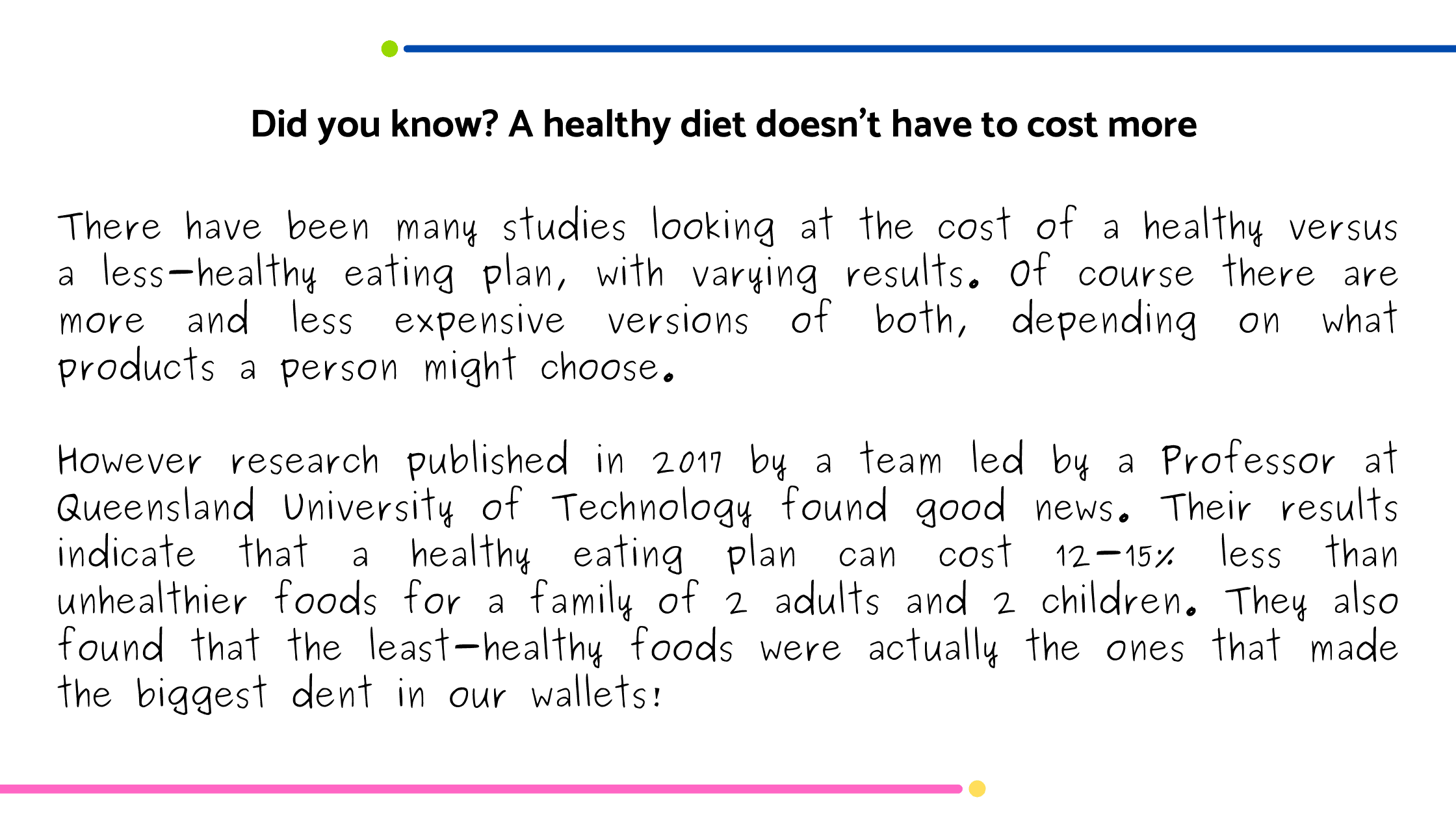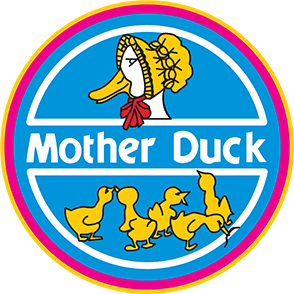
Healthy Family Food On A Budget
I’ve often had people tell me that they’d like to eat more healthily but it’s just too expensive. And it’s absolutely true that specially marketed ‘health foods’ are often very costly. However, almost no-one needs these ‘health foods’. This month I’m exploring ways to cut the family food budget while still giving children (and their parents) a nutritious diet that meets their needs.
The first step is planning
How often do we look back at the end of the week and think, ‘Wow – where did the money go?’ But by taking a few minutes to plan the family meals for the week, some extra expenses can be avoided.
It helps to use the plan to make a shopping list, so only food that’s needed goes into the shopping trolley. Very organised people might even plan meals with leftovers in mind. For example, a generous batch of chili con carne might give you a filling for tacos as well.

Budgeting by food group
Meat and protein foods:
If we eat meat, chicken or fish, these are some of the most expensive foods in our shopping trolley – but there are ways to reduce the costs:
- Most adults eat more meat and other protein foods than our bodies need. Limiting the ‘meat’ serve to a quarter of an adult plate is a good start to controlling costs. Dishes such as curries, salads and stir-fries can all be made with less meat and more vegetables.
- Veggie protein sources such as tofu, chickpeas and lentils are much less expensive. Adopting a veggie ‘day’ such as meat-free Monday is a great way to save a few dollars and maybe reap some health benefits as well. You could also try a mix of meat and plant-based protein sources, such as beef mince mixed with quorn mince in spaghetti Bolognese.
- Cheaper cuts of meat such as chuck steak and lamb shoulder are really flavoursome but require a long cooking time, meaning you need to plan ahead. This does make them a perfect option for buying in bulk and cooking several nights’ worth of dishes such as curries or casseroles.
- A whole chicken is generally less expensive per serve than chicken breast, other pieces or sliced sandwich meat. A regular meal plan in our house is roast chicken (one of the few meals all the children and adults enjoy) followed by leftovers appearing as chicken, cherry tomato, broccoli, and pesto pasta (a quick meal for busy nights) and chicken sandwiches.
- Canned fish is a convenient source of protein and key nutrients, particularly the omega-3 fish oils in varieties such as canned salmon and sardines. It’s also much less expensive than fresh fish. While the taste is quite strong, sardines are one of my 7-year-old’s very favourite foods!
- Egg-based meals such as omelettes are an easy option that’s cheaper than meat, but with similar nutritional values.

Milk and dairy foods:
Dairy foods are the most expensive food group after meat. Most people don’t need special, more expensive milks, and can digest regular milk with no problems. Simply keep in mind that children under the age of 2 need whole or full-fat dairy foods. Above this age most children can change to reduced-fat types.
Fruit and vegetables:
The key to paying less for fruit and veg is to buy those that are in season. As a bonus, they may be more flavoursome and nutritious because they haven’t been stored for as long. Look in the More Information section for a link to a guide to seasonal produce. Also remember:
- Only buy fresh fruit or vegetables you can use before they spoil. You can always supplement them with frozen fruit and vegetables, which are generally cheaper than fresh, and just as healthy. Canned fruit and veg are also a good option but look for veg without added salt and fruit canned in juice rather than syrup.
- One generally unnecessary item in this group is juice. With the possible exception of children who just can’t be persuaded to eat fruit, we don’t actually need juice. And it should always be well diluted with water for very young children.

Grain foods:
Basic grain foods such as bread, rice and pasta are very inexpensive, and ideal fuel foods for little tummies. However:
- The less-healthy occasional foods in this group are often more expensive – biscuits, croissants and pastries spring to mind.
- Breakfast cereals can be a huge money drain plus a source of lots of sugar. Check the label to avoid those that are super-sweet – the less sugary types are often less expensive. You can always add fruit for sweetness.
Ready meals and takeaways:
These are the most expensive foods we buy to eat at home, but also the ones where planning can make the most difference.
- Meals like stir-fries and pasta with sauce can be almost as fast to put on the table as a ready meal, and certainly faster than a take-away meal, if all the ingredients are already prepared.
- If you can find a few minutes to chop a little extra meat or fish and veg and put them in individual portions in the freezer, then a nutritious stir fry is only a few minutes away. Make extra pasta sauce and freeze individual or family-sized portions and you’ll have another meal in the time it takes to boil pasta.
- Takeaway meals aren’t just for busy evenings though – they’re also a nice treat, and fun to create at home. Kids love designing their own pizza toppings and burger fillings, and the food will be healthier for both your family and your wallet.

Other tips on shopping:
Home-brand foods are generally the same in terms of nutrition but lower in cost than ‘name’ brands, so there’s no health downside to choosing them.
To avoid unnecessary but expensive ‘extras’, try to skip the sweets, chips and sweet drinks aisles completely.
Foods with extra packaging, like small individual yogurt pots or cheese segments are convenient and maybe fun for kids, but definitely not essential – splitting up bigger packs will always cost less cash and save on packaging.

Other tips on food for the little ones:
Buying baby’s first foods can be pretty expensive, given that it’s often just pureed vegetables and rice. However, it’s incredibly cheap, if a bit fiddly and time consuming, to make it at home and freeze mini-portions in ice-cube containers. And, if you’ve ever tasted the bought version, you’ll know that home-made baby-food is so much yummier for their developing taste buds.
If you’re feeding several age groups, such as babies, toddlers, and adults, you’ll know that it’s a hassle, as well as more expensive, to make lots of different meals. You may be able to think of dishes that can be modified to suit all the family. For example, cooked meat from roast chicken can be blitzed with roast potato (after taking off any hard bits) and roast carrot to make meals for a baby. Just be sure not to add salt when cooking.
The range of fun kids’ snack foods in the supermarket seems to get bigger every time we visit. Of course, none of these foods are essential, though children’s pester power can make them difficult to resist. One strategy might be to keep all treat foods off the shopping list but agree to buy just one ‘treat food’, when out shopping with your child. While they’re generally not very healthy (no matter what the labels imply!), those based on yogurt, cheese or fruit will at least provide some useful nutrients.
Over to you…
Have you got a great food budgeting tip you’d like to share with other Mother Duck families? Please pass it on to a member of staff who can send it to me and I’ll include it in a future blog.
For more information: Here’s a useful guide to when fruits and vegetables are in season in Brisbane.
© Fiona Hinton 2021
About Fiona: Fiona Hinton is a dietitian, but describes herself as a nutrition translator, taking the science of nutrition and translating it into foods we love to eat, to nourish both body and soul. She has over 20 years of experience as a dietitian, working in a wide range of areas from hospital wards to running her own private practice. Fiona has a special interest in children’s nutrition. As a mum of three school-age boys, she has first-hand experience of the issues associated with feeding young children, such as weaning and fussiness. Fiona specialises in real-life strategies and practical suggestions to convert nutrition advice into food kids will eat. Fiona has collaborated on several books, including one with best-selling children’s food writer Annabel Karmel, as well as training childcare staff in children’s nutrition.


